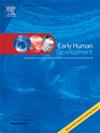母亲妊娠期体重增加和小胎龄儿童的长期身体和神经预后:一项基于纵向队列的4年真实世界研究。
IF 2
3区 医学
Q2 OBSTETRICS & GYNECOLOGY
引用次数: 0
摘要
背景:在全球范围内,小胎龄(SGA)越来越普遍,与常见的高危妊娠与不适当的妊娠体重增加(GWG)平行。然而,母亲的GWG是否与SGA后代的长期发育有关仍未得到解决。目的:通过本院真实队列研究产妇GWG与SGA患儿长期生理和神经发育的关系。研究设计:本回顾性队列研究于2020年7月1日至2022年12月在我院进行。在基线时,我们纳入了319名被诊断为SGA的儿童,并对这些儿童进行了12至48个月的随访(中位数:29个月)。主要结果是随访时儿童的身体和神经发育情况,这些儿童被分为母亲GWG不足、足够或过量的儿童。我们将不同年龄和性别儿童的体重、身高(长)、体重指数和ASQ-3 / ASQ:SE域分数标准化为z分数,以增加可比性。采用Hosmer-Lemeshow检验模型计算校正优势比(OR)及其95%置信区间(CI),以评估神经发育受损的风险。结果:第一,GWG不足组新生儿出生体重和出生体长均小于GWG充足组和GWG过量组。GWG不足组发生严重SGA、新生儿呼吸窘迫综合征和支气管肺发育不良的比例高于GWG充足组。其次,随访观察发现,与GWG充足组相比,GWG不足组的体重Z评分(0.12 vs 0.34)、身高Z评分(-0.11 vs 0.32)显著降低,消瘦发生率(14.3% vs 5.0%)较高。第三,在神经发育随访中,GWG充足组儿童在大运动、精细运动、问题解决和个人-社会领域的Z得分显著高于GWG不足组,在大运动领域的Z得分显著高于GWG过量组;与GWG不足组相比,GWG过量组的儿童在精细运动和个人社交领域的Z得分在统计上更高。GWG不足组与大运动(OR 1.79, 95% CI 1.15-2.77)、精细运动(OR 1.6, 95% CI 1.06-2.78)、问题解决(OR 2.08, 95% CI 1.16-3.56)、个人-社会(OR 1.51, 95% CI 1.05-2.18)和社会情感(ASQ:SE) (OR 1.84, 95% CI 1.05-3.22)领域的延迟发展风险显著相关。同时,与足量组相比,过量组与大运动迟缓风险显著相关(OR 1.6, 95% CI 1.02-2.48)。结论:产妇GWG不适当(不足或过量)可能影响SGA儿的长期生理和神经发育。孕妇,特别是宫内生长受限的孕妇,需要保持合理的GWG,密切监测,及时干预,以改善SGA患儿的长期预后。本文章由计算机程序翻译,如有差异,请以英文原文为准。
Maternal gestational weight gain and the long-term physical and neurological outcome of small for gestational age children: A 4-year real-world study based on a longitudinal cohort
Background
Globally, small for gestational age (SGA) is increasingly prevalent, paralleling the common high-risk pregnancies with inappropriate gestational weight gain (GWG). However, whether maternal GWG was associated with their SGA offspring's long-term development remained unresolved.
Objective
To examine the associations of maternal GWG with the long-term physical and neurological development of SGA children based on a real-world cohort in our hospital.
Study design
This retrospective cohort was conducted at our hospital between July 1, 2020, and December 2022. At baseline, we included 319 children diagnosed as SGA and followed up with these children for 12 to 48 months (median: 29 months). The primary outcomes were children's physical and neurological development at follow-ups which were grouped into those with inadequate, adequate, or excessive maternal GWG. We standardized the weight, height (length), body mass index, and ASQ-3 / ASQ:SE domain scores of children with different ages and genders into Z-scores to increase comparability. The adjusted odds ratio (OR) and its 95 % confidence interval (CI) controlling for covariates were calculated using the Hosmer-Lemeshow test model to assess the risk of impaired neurodevelopment.
Results
Firstly, the birth weight and birth length of newborns in the inadequate GWG group were both smaller than those in the adequate GWG group and excessive GWG group. The proportions of severe SGA, neonatal respiratory distress syndrome, and bronchopulmonary dysplasia were higher in the inadequate GWG group compared to the adequate GWG group. Secondly, follow-up observations found that inadequate GWG group had significantly lower weight Z scores(0.12 vs 0.34), height Z scores(−0.11 vs 0.32)and high emaciation incidence (14.3 % vs. 5.0 %) compared to the adequate GWG group. Thirdly, in the follow-up of the neurodevelopment, children in the adequate GWG group had statistically higher Z scores in the gross motor, fine motor, problem-solving and personal-social domains compared to those in the inadequate GWG group and had statistically higher Z scores in the gross motor domain compared to those in the excessive GWG group; children in the excessive GWG group had statistically higher Z scores in the fine motor and personal-social domains compared to those in the inadequate GWG group. Inadequate GWG group was significantly correlated with a higher risk of delayed development in gross motor (OR 1.79, 95 % CI 1.15–2.77), fine motor (OR 1.6, 95 % CI 1.06–2.78), problem-solving (OR 2.08, 95 % CI 1.16–3.56), personal-social (OR 1.51, 95 % CI 1.05–2.18), and social-emotional (ASQ:SE) (OR 1.84, 95 % CI 1.05–3.22) domains than adequate GWG group. Meanwhile, excessive GWG group was significantly correlated with a higher risk of delayed development in gross motor (OR 1.6, 95 % CI 1.02–2.48) domain than adequate GWG group.
Conclusion
Inappropriate maternal GWG (inadequate or excessive) may affect the long-term physical and neurological development of SGA infants. Pregnant women, especially those with intrauterine growth restriction, need to maintain reasonable GWG and receive close monitoring and timely interventions to improve SGA children’ long-term outcomes.
求助全文
通过发布文献求助,成功后即可免费获取论文全文。
去求助
来源期刊

Early human development
医学-妇产科学
CiteScore
4.40
自引率
4.00%
发文量
100
审稿时长
46 days
期刊介绍:
Established as an authoritative, highly cited voice on early human development, Early Human Development provides a unique opportunity for researchers and clinicians to bridge the communication gap between disciplines. Creating a forum for the productive exchange of ideas concerning early human growth and development, the journal publishes original research and clinical papers with particular emphasis on the continuum between fetal life and the perinatal period; aspects of postnatal growth influenced by early events; and the safeguarding of the quality of human survival.
The first comprehensive and interdisciplinary journal in this area of growing importance, Early Human Development offers pertinent contributions to the following subject areas:
Fetology; perinatology; pediatrics; growth and development; obstetrics; reproduction and fertility; epidemiology; behavioural sciences; nutrition and metabolism; teratology; neurology; brain biology; developmental psychology and screening.
 求助内容:
求助内容: 应助结果提醒方式:
应助结果提醒方式:


